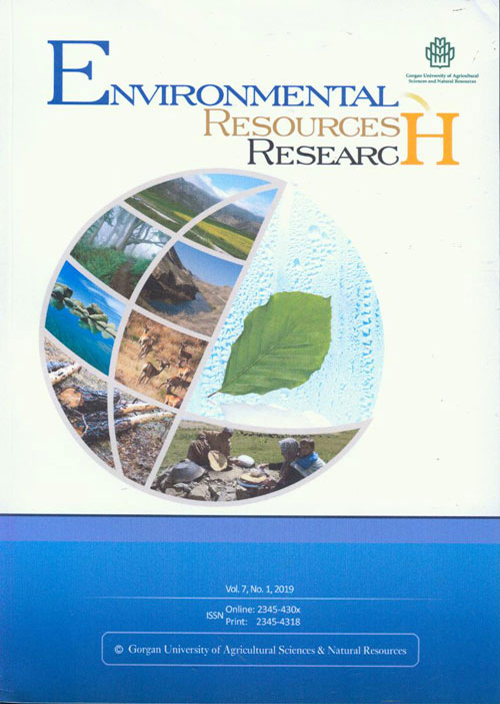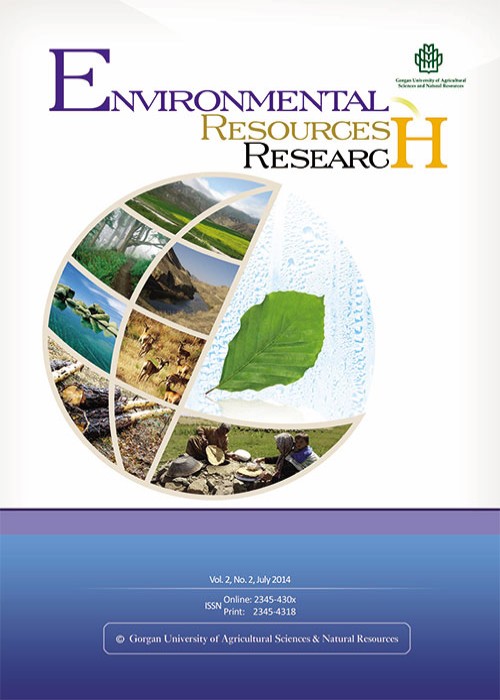فهرست مطالب

Journal of Environmental Resources Research
Volume:8 Issue: 2, Summer-Autumn 2020
- تاریخ انتشار: 1399/12/17
- تعداد عناوین: 7
-
-
Pages 97-108
For a given sample of grouped and ungrouped (raw) data, the maximum likelihood (ML) estimator is obtained using iterative algorithms such as Newton -Raphson (NR), which may not be converged always. Three-parameter Birnbaum-Saunders (BS) and Weibull distributions are frequently used in forestry and environmental sciences. In this study, we suggest using the expectation-maximization (EM) algorithm to estimate the parameters of BS and Weibull distributions when these models are fitted to grouped data. The EM algorithm is an iterative procedure that is used to obtain the ML estimator and always converges, whereas it is shown through simulation that the NR method may fail to converge. We demonstrate through three illustrations that the EM algorithm applied to the grouped data works efficiently. For the first illustration, the ML estimates of the grouped data exist and they are almost the same as the output of the EM algorithm. In the second and third real data examples that are of small sizes, the ML estimator does not exist for the ungrouped data but, we find it using the EM algorithm applied to the grouped data.
Keywords: Birnbaum-Saunders distribution, diameter modelling, expectation-maximizationalgorithm, Forest management, Grouped data, Maximum likelihood method, Weibulldistribution -
Pages 109-120
Over the last three centuries, worldwide improper utilization of rangelands has led to degradation of ecosystem services. Rangelands, like other natural resources used by humans, are embedded in complex socio-ecological systems. To determine how to better manage this important resource, we developed a rangeland ecosystem services model using the Driver-Pressure-State-Impacts–Response (DPSIR) conceptual model. The model was tested in a river basin in north-east of Iran. We asked 56 experts and 42 local land users on their perceptions of rangeland changes, causes of change, and possible actions to mitigate impacts using Delphi method, workshops, and questionnaires. A Multi-Criteria Decision Making method was used to evaluate the perceived interactions among the components of the DPSIR framework. Climate change and rangeland degradation were the most important pressures, leading to a decline in rangeland production, decreased vegetation cover, and land-use change. Experts and locals argued that forage and herbal species production, erosion control, and flood control were the most affected ecosystem services. They suggested the use of resistant plants, local training, and rangeland rest to manage these problems. The DPSIR framework was useful in developing a comprehensive insight for local people and managers on the social and ecological complexity of rangelands and the potential responses for coping with pressures.
Keywords: Rangeland management, MCDM, Pairwise comparison, Sustainabledevelopment -
Pages 121-128
Estimating crop area is a key factor for crop monitoring and agricultural management. Having annual information on crop acreage and production change is necessary for agricultural decision-makers and planners. In recent years, the cultivation of saffron in Nishabur has received more attention by farmers due to low water requirements and its good income. Planning for the marketing of this strategic product and the provision of agricultural inputs for saffron requires that the information of the area under its cultivation be estimated accurately. The aim of this study was to monitor changes in cultivated areas and to estimate the saffron area using satellite imagery with different spatial resolutions and time series normalized different vegetation indexes (NDVITs). Using Landsat 8 satellite images and time difference methods based on plant phenology estimate the areas under cultivation of saffron was estimated in Fazl Village of Nishabur County. A satellite image of June 17, 2016, related to the plant's dormant phase and another on January 11, 2017, for the vegetative growth stage of saffron was prepared. Using different vegetation indices, saffron cultivation was distinguished from other agricultural products and estimated at 497 hectares with an overall accuracy of 72% and a kappa value of 71%. Also, the results indicated that the accuracy of this method depended on the patch area of agricultural lands, such that in areas less than 2000 square meters, the user's accuracy was 44 percent, in lands with an area between 2000 and 5000 square meters, the accuracy was 66 percent, while in farms between half to one-hectare, the accuracy reached 80% and in lands more than one hectare, the accuracy was 89%. The results of this research indicated that the use method is suitable for estimating the area under the cultivation of saffron and we suggest its examination in other parts of the country.
Keywords: Landsat, NDVI, Phenology, Vegetation index, Remote sensing -
Characterizing soil infiltration parameters using field/laboratory measured and remotely-sensed dataPages 129-145
Characterizing soil infiltration parameters is time consuming and costly. We carried out the current research to predict different parameters of soil infiltration using field/laboratory measured and remotely-sensed data. The investigated parameters included infiltration rates at different time intervals and the parameters of the three well-known infiltration models. We employed soil sampling and field measurements on late spring 2012 and acquired ETM+ data for the correspondent dates. We measured several soil properties as well as infiltration. Then, we developed several pedo-transfer functions (PTFs) from the collected field/laboratory measured and remotely sensed data to predict the intended infiltration parameters. Results showed that field/laboratory measured data were able to predict soil infiltration rates and parameters of the investigated models with reasonably high accuracies (E value up to 0.961). The results also revealed that, although there was no significant and robust relationship between soil surface reflectance and the investigated parameters, the developed PTFs had reasonable accuracies (E value up to 0.634) in estimating the intended infiltration parameters using soil characteristics (moisture content, soil separates, and organic carbon) which are predictable from remotely sensed data.
Keywords: Lighvan watershed, Remote sensing, Soil infiltration, Pedo-transfer functions -
Pages 147-160
Erosion by water leads to considerable impacts on natural ecosystems and is accelerated in regions with high land use changes. In this study, through applying the K-means clustering approach on the output of SWAT model, the critical areas with respect to water erosion for Farsan Basin was prioritized for Best Management Practices (BMPs). Based on the results of SWAT model, three pollutant indicators were developed: i) contaminat Load per Unit Area Impact Index (LUAII), ii) contaminates Concentrating Impact Index (CII) and iii) the contaminat Load Impact Index (LII). The basin was divided into 26 sub-basins and according to the clustering results; the southern sub-basins which are situated on sloped areas (more than 25 degrees) were classified as high priority areas for management practice based on all indices. Sub-basins that are located in west, south west and south east have medium priority. These sub-basins are very sensitive to land use change including decreasing rangeland and increasing farming area. Among all sub-basins, those which are placed around two major streams are in stable condition because of low slope and low land use change. Finally, using the results of pollution indicators, we showed it was possible to reduce sediment and nutrient waste through implementing best management methods.
Keywords: Critical areas, SWAT Model, Farsan Watershed, Land Use, Pollution Indicators -
Pages 161-174
In this study, a hybrid support vector machine–artificial flora algorithm method was developed to estimate the flow rate of Karkheh Catchment rivers using daily discharge statistics. The results were compared with those of the support vector–wave vector machine model. The daily discharge statistics were taken from hydrometric stations located upstream of the dam in the statistical period 2008 to 2018. Necessary criteria including coefficient of determination, Root Mean Square Error (RMSE), Mean Absolute Error (MAE), and Nash– Sutcliffe coefficient were used to evaluate and compare the models. The results illustrated that the combined structures provided acceptable results in terms of river flow modeling. Also, a comparison of the models based on the evaluation criteria and Taylor’s diagram demonstrated that the proposed hybrid method with the correlation coefficient R 2= 0.924-0.974, root-meansquare error RMSE= 0.022-0.066 m3 /s, mean absolute error MAE= 0.011-0.034 m3 /s, and Nash-Sutcliffe coefficient NS=0.947-0.986 outperformed other methods in terms of estimating the daily flow rates of the rivers.
Keywords: Artificial flora, Support vector machine, Wavelet, Karkheh catchment -
Pages 175-185
Primary production is the most important functional feature of terrestrial and aquatic ecosystems affecting many processes. In this study, we integrated logistic regression and Markov chain to predict chlorophyll-a (chl-a) concentration as an index of primary production in the Caspian Sea. We categorized the continuous variable, chl-a, using quantile method for analysis and prediction. Remotely-sensed data of chl-a and nine environmental variables were downloaded from MODIS dataset for the years 2013 and 2016. The level of chl-a in 2019 was predicted across the Caspian Sea. Chl-a data was divided into three distinct levels (i.e. low, medium and high) based on 0.33 and 0.67 quantiles, and a logistic regression model was used based on transition between the levels of chl-a between 2013 and 2016, and between 2016 and 2019. The Markov chain modelling indicated an increasing trend in chl-a levels (low to medium, low to high, medium to high) for some parts of the Caspian Sea, and also a stable condition for other parts including transition from medium to medium, high to high had the highest transition probabilities for both periods. From 2013 to 2019, the calculated areas of the pixels having low levels of chl-a decreased and there were considerable increases in the areas with medium and high chl-a levels. Accordingly, the chl-a level in the Caspian Sea at 2019 was predicted to be higher than those of the previous years, especially in the middle and southern parts of the Sea
Keywords: Primary production, Caspian Sea, Simulation, Spatiotemporal, Modelling


